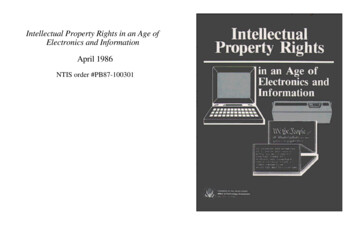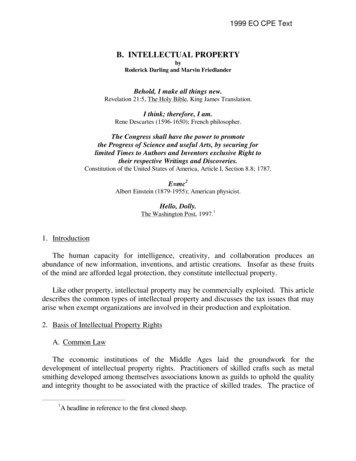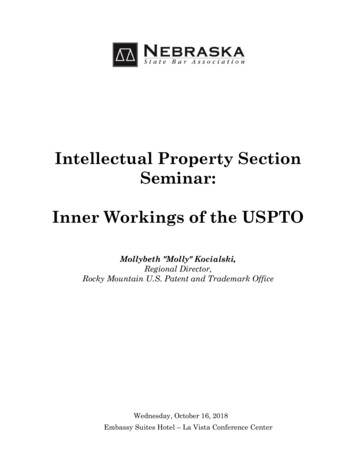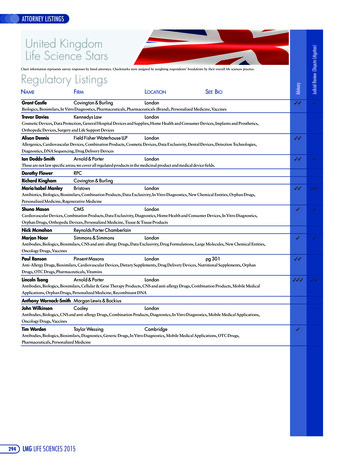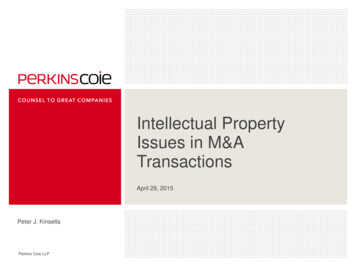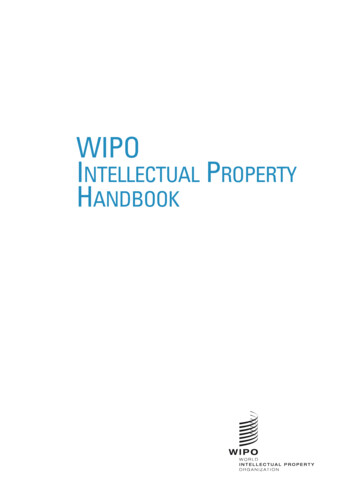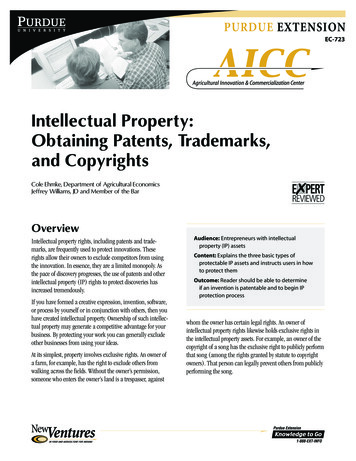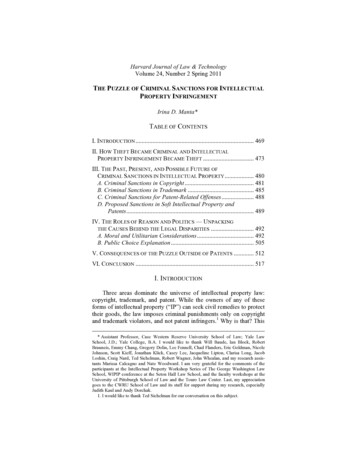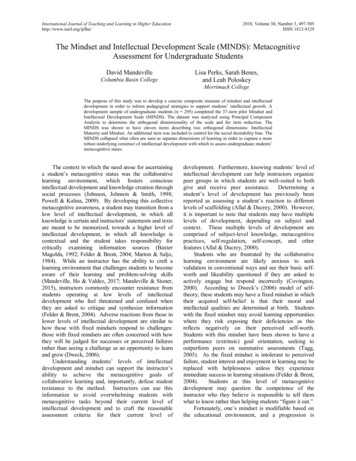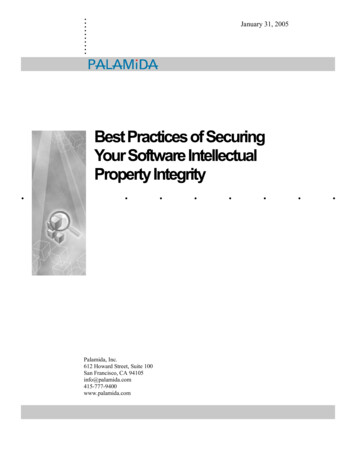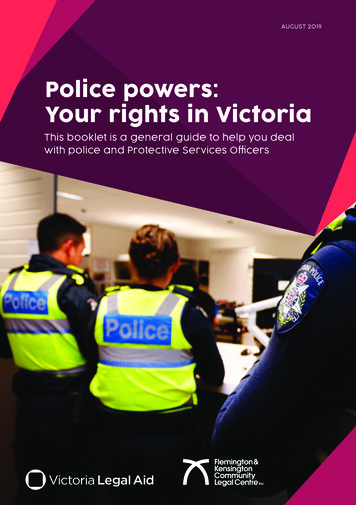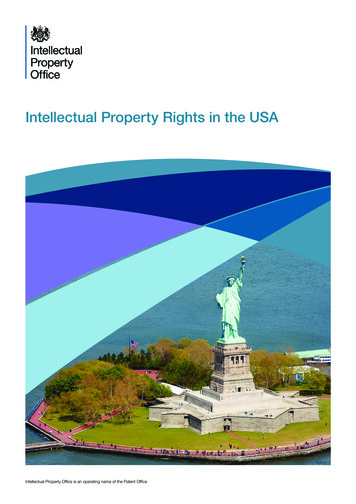
Transcription
Intellectual Property Rights in the USAIntellectual Property Office is an operating name of the Patent Office
ContentsIntellectual property rights in the USA3What are intellectual property rights?3International considerations3Treaties and reciprocal agreements4Intellectual property rights - systems in the USA4Copyright4Patents5Trade marks5Registering and enforcing your intellectual property rights in the USA6Patents6Trade marks7Copyright7Enforcing your IP rights in the USA8Protecting your IP8Potential problems faced in the USA and how to deal with them9Avoiding problems9Who should take responsibility for your IP protection?9Top tips for IP protection in the USA10Where to get intellectual property help in the USA10Related web sites you might find useful11Intellectual Property Rights in the USA1
Intellectual property rights in the USAIf you plan to do business in the USA, or if you are already trading there, it is essential to know how to use, guardand enforce the rights you have over the intellectual property (IP) that you or your business own.This guide explains about IP rights in general, and gives guidance on how to apply these principles in the USAmarket. It describes the issues you may face with IP infringement in the USA, offers advice on how you caneffectively tackle these, and provides links to sources of further help.What are intellectual property rights?Intellectual property (IP) is a term referring to a brand, invention, design or other kind of creation, which a personor business has legal rights over. Almost all businesses own some form of IP, which could be a business asset.Common types of IP include:yCopyright - this protects written or published works such as books, songs, films, web content and artisticworks.yPatents - this protects commercial inventions, eg a new business product or process.yDesign right - this protects designs, such as drawings or computer models.yTrade marks - this protects signs, symbols, logos, words or sounds that distinguish your products and ser vices from those of your competitors.IP can be either registered or unregistered.With unregistered IP, you automatically have legal rights over your creation. Unregistered forms of IP includecopyright, unregistered design rights, common law trade marks and database rights protection for confidentialinformation and trade secrets.With registered IP, you will have to apply to an authority, such as the Intellectual Property Office in the UK, tohave your rights recognised. If you do not do this, others are free to exploit your creations. Registered forms of IPinclude patents, registered trade marks and registered design rights.International considerationsThe USA has been a World Trade Organization (WTO) member since 1995. WTO member nations must includesome IP protection in their national laws. This means that if you are doing business with the USA, you will findsome similarity between local IP law and enforcement procedures, and those in force in the UK.Intellectual Property Rights in the USA3
Treaties and reciprocal agreementsThe USA is a signatory to the following international IP agreements:ythe Paris Convention - under this, any person from a signatory state can apply for a patent or trade markin any other signatory state, and will be given the same enforcement rights and status as a national of thatcountry would beythe Berne Convention - under this, each member state recognises the copyright of authors from other memberstates in the same way as the copyright of its own nationalsythe Madrid Protocol - this is a central system for obtaining a ‘bundle’ of national trade mark registrations indifferent jurisdictions, through a single applicationythe Patent Co-operation Treaty - this works in much the same way as the Madrid Protocol, but for patentapplicationsThe USA is not a signatory to the Hague Agreement, which allows the protection of designs in multiple countriesthrough a single filing.Intellectual property rights - systems in the USACopyrightIn the United States, creative work is automatically protected by copyright as long as it is both:yoriginal - ie independently created and not copied from someone else’s work.yfixed in a tangible form - ie easy to see, reproduce or communicate over a long period of time.Copyright only protects the tangible form of your creative work - it does not protect the idea itself, only the formit takes. For example, if your business has an advertisement, the actual content is protected by copyright, but itdoes not prevent others from using a similar idea to create their own advertisement.Although registration of copyright is not a legal requirement in the USA, it is advisable. This is because it:yestablishes a public record of ownership and strengthens your position in the case of copyright infringement;yis necessary in order to press charges for copyright infringement in Federal courts;yis necessary to prevent infringing imports from entering the USA; andyallows you to claim statutory damages and attorney’s fees in the case of copyright infringement - rather thanneeding to prove actual damagesAs the copyright owner, only you have the right to copy, change, distribute or publicly display the work, orauthorise others to do so. However, if you employ other companies or freelancers for certain works, it could bethat they own the copyright - eg an external graphics designer may own the copyright for their commissionedwork. It is therefore recommended that you always use a contract to clarify who owns the IP.4
The USA is a signatory to the Berne Convention on copyright. Under this, each member state recognises thecopyright of authors from other member states in the same way as the copyright of its own nationals.In the USA, work created on or after 1 January 1978 is protected for:ythe life of the author plus 70 years - if the owner is a persony95 years from publication or 120 years from the creation of the work, whichever is shorter - if the owner is acorporation or other entityAll other work created before 1978 is governed by the Copyright Act of 1909. This provides initial protection of28 years, with the chance of subsequent renewal. If the copyright of a published material has expired, it is usuallyconsidered to be in the public domain, making it free for anyone to use.PatentsA patent is a governmental grant that allows someone to protect an invention. In the USA, the United StatesPatent and Trademark Office (USPTO) issues three kinds of patents:yUtility patent - for technological advances and innovations. This lasts a minimum of 20 years from the date ofapplication.yDesign patent - for new and original designs for items. This lasts for a 14-year term.yPlant patent - for the invention or discovery of any distinct and new plant varieties that has been asexuallyreproduced by grafting or selective cuttings (without seed manipulation). This protection is different to plantvariety protection which is administered by the United States Department of Agriculture. This lasts for a 20 year term from the date of application.If you need to pitch an invention or design that has not yet been patented, you should use a non-disclosureagreement or obtain a provisional patent application. You should also keep any and all documents relating to theinvention or design.The September 2011 America Invents Act (AIA) amended US patent law to make it a “first inventor to file” system,which is in line with other patent systems, including the UK. The “first inventor to file” system means that whoeverfiles a patent application first can be awarded a patent. The AIA first-inventor-to-file provisions became effectiveon March 16 2013.US law also allows a one-year grace period for an inventor to register a patent from the date of public disclosure.You should note that this is different from European countries, where public disclosure could prevent you frombeing able to obtain a patent.Trade marksUnlike copyright, trade marks are not automatic and are generally only protected if registered in the USA.In most countries, trade mark rights are established through registration - this is known as ‘First to File’. However, in the USA,as in the UK, the ownership of a trade mark is established by whoever first uses it in commerce. This is known as the ‘Firstto Use’ system and requires you to actually use the mark in connection with goods or services in order to protect your trademark. Therefore, if there is a dispute between you and another party over a trade mark, whoever used it first commercially willown the right, even if they did not register it.Intellectual Property Rights in the USA5
However, in order to completely protect your trade mark in the USA, you should also register it through the USPTO. Registeringyour trade mark also provides several further benefits to you, including:ypublicly declaring your ownership of the trade markyhelping you to register your trade mark in other countriesyhelping you to bring any legal action to the Federal courts and preventing infringing material from beingimportedyallowing you to use the registered trade mark symbol ( ) with your trade markBecause registration is not a requirement, there is no limit to the duration of a trade mark in the USA. As long asthere is continued use of the trade mark, ownership of the trade mark right is maintained.Registering and enforcing your intellectual property rights inthe USASome types of intellectual property (IP) rights in the USA are automatic, but it is recommended that you alwaysregister them to both protect yourself and to make the most of your IP rights.‘Priority rights’ under the Paris Convention can help in the local registration of trade marks, designs and patentsby allowing rights previously registered elsewhere to become effective in the USA, if filed within a time limit.As a signatory of the Paris Convention, the USA must also provide protection against unfair competition in linewith the rules of the Convention.PatentsTo obtain patent protection, you must register your invention with the United States Patent and Trademark Office(USPTO), usually with the help of a patent attorney. You can either apply for a:yutility patent - for innovations and technologiesydesign patent - for new and original designsyplant patent - for distinct and new plant varietiesUnder US law, if your invention is publicly disclosed without a patent, you have a grace period of one year toregister your patent.The application process for patents is complex, and it is highly recommended that you seek advice from apatent attorney before going ahead. A patent attorney will help you make sure that your invention is not alreadyregistered by someone else, and will assist you in completing a patent application. You can find a list of registeredUS patent attorneys on the USPTO website.6
The fee for patent applications can vary depending on your application, and the approval process can take a verylong time and varies from each application. There is a 50 per cent discount on official fees for registering a patent forsmall companies, non-profit organisations and universities. There is also a 75 per cent discount on fees for a ‘microentity’, though these have strict criteria you must meet in order to be eligible. For example an inventor must not:yhave an annual income more than three times the average household annual incomeyhave been named on more than four US patent applicationsyassign or license their patent to a company or person that has more than three times the average householdannual incomeThere is no legal protection for a patent until it has been approved.Once your patent is approved, you will need to pay a regular maintenance fee in each country that your patent hasbeen granted.Trade marksIn the USA, it is the first party who uses a trade mark commercially that owns the rights for that trade mark. Trademark registration is therefore not a legal requirement, but it does hold several benefits.To register your trade mark in the USA, you can either register with the USPTO within the USA or use the MadridProtocol to gain unitary rights under national or Community Trade Mark registration systems.Registering a trade mark in the USA can be a complicated process, so it is recommended that you seek expertlegal advice before proceeding.If you register your trade mark with the USPTO it can also be recorded with the United States Customs andBorder Protection (CBP), a bureau of the Department of Homeland Security. This can be done electronically andwill help the fight against fake and pirated goods being imported to the USA.CopyrightFor copyright, both published and unpublished, no registration is required but registering copyrights with thecopyright authorities is advisable.To register a copyright in the USA, you will need to complete the relevant application form, either online or bysending it to the United States Copyright Office, along with the appropriate fee.You can also protect your work with a copyright notice - eg by displaying the copyright symbol ( ), year of firstpublication and your name as the copyright owner. This will further deter any copyright infringement of your workand could also help with any legal issues surrounding your copyright.Intellectual Property Rights in the USA7
Enforcing your IP rights in the USAIt is your responsibility to protect your IP, though governmental authorities can help you take steps to preventand stop any infringements. You should actively monitor the marketplace for any unauthorised use of your IP,and if you think that a person or business has unlawfully used your IP, you should take expert legal advice beforecontacting an offender or pursuing any sort of litigation.IP law in the USA is complex and should only be used when other enforcement methods have failed to preventan infringement. If litigation is necessary, then you should use a lawyer who specialises in IP law. Litigation takesplace before either civil courts or administrative tribun
If you plan to do business in the USA, or if you are already trading there, it is essential to know how to use, guard and enforce the rights you have over the intellectual property (IP) that you or your business own. This guide explains about IP rights in general, and gives guidance on how to apply these principles in the USA market. It describes the issues you may face with IP infringement in .
